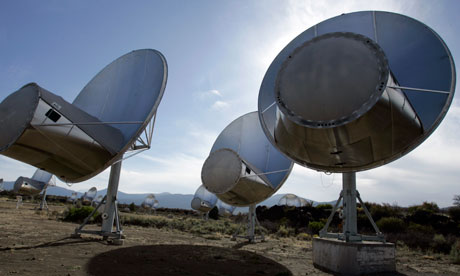It is the scientific institute made famous in Carl Sagan's novel Contact, the organisation for which the main character, Ellie Arroway – played by Jodie Foster in the 1997 film version – worked day and night looking for signs of intelligent life in outer space.
In real life, the Seti Institute has spent five decades hunting the skies for radio signals from deep space, possible communications which may indicate we are not alone in the universe. Now it has fallen prey to a very earthly problem: it has run out of cash. The institute's chief executive, Tom Pierson, has announced that there are "serious challenges" in finding operating funds and that from this week the organisation's brand new $50m (£30m) telescope array will be placed into hibernation. "This means that the equipment is unavailable for normal observations and is being maintained in a safe state by a significantly reduced staff," he said in a letter to private donors to the institute.
The problems revolve around the operation of the Allen Telescope Array (ATA), a set of radio dishes dedicated to looking for alien signals. Though it was paid for by the Seti Institute, the array, at the Hat Creek Radio Observatory, 300 miles north-east of San Francisco, is managed and operated by the radio astronomy lab of the University of California, Berkeley.
According to Seti senior astronomer Seth Shostak, the facility needs about $2m-$3m a year to function and to keep the scientific research programmes going. The scientists need an additional $5m to fund a two-year project to listen for possible radio signals coming from the Earth-like exoplanets found by Nasa's Kepler satellite. Launched in 2009, it has already identified more than 1,000 candidate planets, which the Seti Institute wants to use to narrow its search.
The money needed to operate the observatory has until now come from a mixture of private donations, the US National Science Foundation (NSF) and the state government of California. "As it happens, Berkeley's budget is way down – the state of California is in terrible financial circumstances because of the economic downturn," Shostak said. "Consequently, they don't have the money to keep the doors open and pay the electric bills and pay the staff at the antenna. And we don't either, because we run our Seti projects mostly based on private donations, and those are down as well." Funding from the NSF has also been cut, to about a tenth of its former level.
Paul Davies, an astrophysicist at Arizona State University, said the ATA facility was "the gold standard for Seti observations and acts as an emblem for the entire worldwide research effort. It would be an utter tragedy if a unique research programme is abandoned for the cost of a few miles of motorway". He added: "Our society squanders vast sums on trivia and entertainment, yet cannot find some small change to address the burning issue of whether we are alone in the universe."
There is some hope of raising funds by working with the US air force on future projects, according to Pierson, with one idea being to use the ATA in collaboration with the USAF's space surveillance network to track debris in space, which can damage satellites and space vehicles. But this is also uncertain, given impending cuts in federal funding for the military.
"The other possibility is that private donations could bring the telescope back to life and keep it working," said Shostak. In the past, science fiction author Arthur C Clarke and Silicon Valley entrepreneurs Bill Hewlett and David Packard had helped fund Seti, he said, and "if Richard Branson or somebody … wanted to help us out now, they can get in touch".
The ATA is the Seti Institute's biggest facility by far, and its only dedicated one. Its shutdown means astronomers will need to rely on data collected during downtime from other telescopes around the world and this will reduce its chances of finding that elusive alien signal.
Shostak said the future of the ATA had to be decided sooner rather than later, as there was only enough money to keep it in hibernation mode for a few months.
Until the funding crisis can be solved, the institute said it would continue its work on developing equipment and software that supports the overall search for alien signals.
This includes an increased focus on involving citizens in its work: astronomers have already developed the successful Seti@Home project, a programme that uses the downtime on people's home computers to sort through the masses of data collected by the institute's experiments.
The next step is SetiQuest.Org, an application that allows "citizen scientist volunteers to look for patterns in data from the ATA that might be missed by current algorithms, and help us explore frequency bands that are so full of signals that our detectors get confused", said Pierson.
Given the improvements in radar technology, Shostak said it would be a shame to stop searching now for signals from ET. "If this experiment is going to work, it's going to work in a few dozen years, simply on the basis of the rapid improvement of the technology afforded by Moore's Law. The equipment keeps getting faster and faster, so I think success is not very far off if you keep doing this."
He added: "In the grand scheme of things, this is not a whole lot of money and, clearly, Seti is an uncertain proposition. But Seti has a long lever-arm because, clearly, if we were to find a signal showing there was intelligent life, that would be an extraordinarily interesting thing. Not only for us but for every generation that follows us."
Seti history
Seti, the Search for Extraterrestrial Intelligence, was conceived in 1960 by astronomer Frank Drake. He pointed the Green Bank radio telescope in West Virginia towards the star Tau Ceti and began looking for anomalous radio signals that might have been sent by intelligent life. Eventually, the Seti Institute was set up in California and began to use the downtime on radar telescopes around the world to scour for signals.
Most recently, the search has been helped by building a dedicated set of antennae, the $50m Allen Telescope Array, 300 miles north-east of San Francisco. Part-funded by Microsoft co-founder Paul Allen, the array has 42 radio dishes, each 6m in diameter, and is the first step in an ambitious plan to build up to 350 antennae to look for radio signals day and night.










